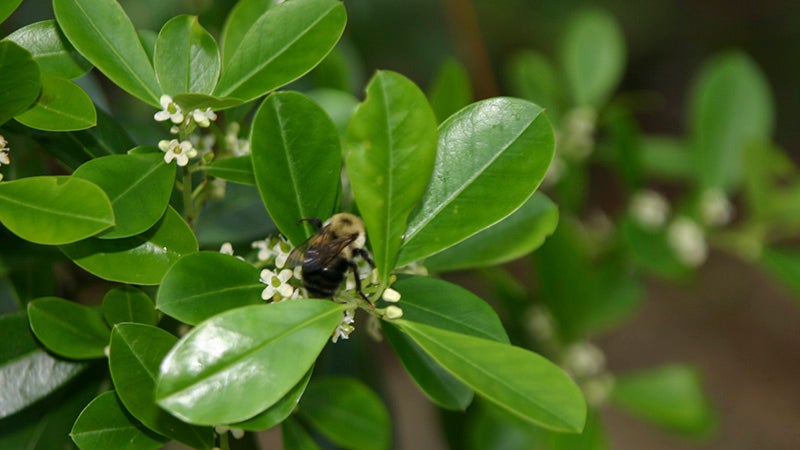Outstanding native plants for wildlife
Published 7:00 am Wednesday, January 3, 2018

- Pictured is a bee in Dahoon Holly 'Perdido' at the Arboretum. Submitted photo
By Pat Drackett, Director, The Crosby Arboretum, MSU Extension Service
In celebration of the winter planting season, this column will focus on some of the many excellent choices of native plant species for the home landscape. While native species are not always readily available, they are well worth the effort to seek out.
Why plant natives? When property sited in your yard according to the environmental conditions they prefer – such as soil type, soil moisture, and sun exposure – they will lend reliable, high performing qualities to your landscape. And who wouldn’t want to add some tough, durable, and beautiful plants to their garden?
Native species also increase the biodiversity of your landscape, which means they will support local wildlife such as birds, butterflies, and bees.
Do you enjoy watching birds? Attract more to your yard by providing them with food, water, and cover. If you regularly put out bird food, try planting some native plants to provide fruit or seeds, or attract insects such as caterpillars, the majority of a baby bird’s diet.
You may already have many native plants growing on your property in areas of natural vegetation, such as thickets. These are plants you may not look twice at, but they are species which often have high wildlife value.
Thickets offer cover and protection to birds, and places to raise their young. Wax myrtle, a common plant in these areas, attracts around fifty different species of birds to feed on the small berries found on the female plants.
Even prickly Smilax vine, called “greenbriar” or “catbriar”, is valuable to birds, who can take cover among these thorny vines that scramble over small trees, offering them both a food source and protection from predators.
Although native hollies such as inkberry, yaupon, and American holly dominate the winter landscape, other plants also have persistent fruit that provides winter food for birds and other wildlife. These include sumac, viburnum, magnolias, American beautyberry, chokeberry, and Virginia creeper.
A good tree for winter birds is sugarberry, also known as hackberry (Celtis laevigata), in the elm family. The tough native tree is good for urban situations, and is a good addition to your wildlife garden as it is loved by flickers, robins, waxwings, hermit thrush, bluebirds, and mockingbirds.
Eastern red cedar (Juniperus virginiana) is a dense conifer that prefers alkaline soils and full sun. It is great for windbreaks or as a screen along property lines. The berry-like cones on the female trees make it highly preferred by many species of songbirds, including yellow-rumped warblers.
If you grow perennials in your garden, consider not cutting the stems back in early fall to “clean up” your landscape. Instead, allow the stems and seed heads to remain, such as coneflowers or sunflowers. These will provide not only a source of food, but opportunities for shelter.
Some great perennials for attracting bees and butterflies include black-eyed Susan, asters, beebalm, coneflowers, coreopsis, Liatris, and milkweed. At the Arboretum, we were surprised to see many bees consistently visiting the flower stalks on our basil plants. While these are a non-native annual, they are high-performers, and loaded throughout the growing season with nectar.
Come visit the Arboretum soon and see our featured winter gallery exhibit, work by Pearl River County Art League Artists of the Year: Paintings by Corey Guerra, woodwork by Laura Ousset, and photographs by Eve Mahoney.
Teachers, homeschool educators, and others in a teaching capacity may attend the free Project WILD teachers’ workshop on Saturday, January 20 with Mississippi Museum of Natural Science Outreach Educator Sabrina Cummings. Sabrina will use wildlife topics to demonstrate how to teach subjects across the curriculum. Space is limited, and reservations are requested. Call 601-799-2311 to sign up.
Mark your calendar for our tenth annual Forge Day, featuring demonstrations by area blacksmiths and metalworkers, on the last Saturday in January, on the 27th from 10 a.m. to 2 p.m.
A prescribed fire workshop will be held Saturday, February 17 from 1:00 to 4:00 p.m. Learn the basics for conducting prescribed burns, including reasons why to manage land through burning, with Extension Forestry Specialist Dr. Glenn Hughes. Cost is $10, and includes refreshments and supplies. Call to sign up, as pre-registration is required.
The Crosby Arboretum is located in Picayune, I-59 Exit 4, at 370 Ridge Road and is open Wednesday through Sunday from 9 AM to 5 PM. For more information, see our schedule of events on our website at www.crosbyarboretum.msstate.



